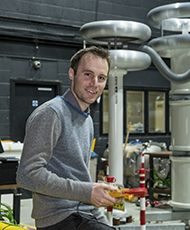Dr James Pilgrim BEng Electrical Engineering, 2007; PhD in Electrical Engineering, 2011
Lead Cable Specialist at Ørsted

I first came to Southampton to study a BEng in Electrical Engineering. I had researched UK universities and knew Southampton was a top university for the subject I wanted to study, and when I visited I felt at home in the environment.
My primary research interests are in high voltage cable systems and I have been actively involved in a range of industrially funded research projects, particularly in the area of Rating Optimisation for Wind Farm Export Cable Systems.
After graduating in 2007, I was appointed as a member of research staff in Electronics and Computer Science (ECS). As well as studying for my PhD in Electrical Engineering, I also worked on a range of projects in the area of high voltage cable systems.
I completed my PhD in 2011 and was delighted to be offered a job as a member of academic staff in ECS. I was keen to explore a career in the university sector and because of the excellent facilities for high voltage engineering at Southampton I would never have chosen to go anywhere else.
Research environment
My research is carried out in the world leading Tony Davies High Voltage Laboratory. The lab is very industry-focused so I felt like I would have the best of both worlds.
My primary research interests are in high voltage cable systems and I have been actively involved in a range of industrially funded research projects, particularly in the area of Rating Optimisation for Wind Farm Export Cable Systems.
We are trying to tackle the problem of the high costs of using export cables to connect wind farms back to shore. At the moment these cables are sized-based upon continuous current ratings, but the power output from wind farms varies with weather conditions and so the actual loading seen by the cable is less severe. This means that the cables may be over-sized for the amount of energy they actually export and therefore are more costly than they need to be.
We are aiming to develop new modelling approaches that will enable the optimal sizing of such cables against realistic wind farm output levels. Accuracy is vital here, as we must manage the balance between reducing costs and any potential increase to the risk of overheating the cables.
Life at Southampton
I have thoroughly enjoyed studying, researching and working at Southampton and would encourage other potential students to consider the University as it has world-leading facilities, lecturers who are passionate about their subjects and are well-connected to industry, and its graduates are highly sought after.
A degree from Southampton is a great start to a career.